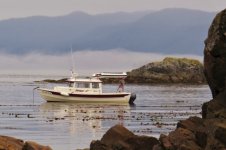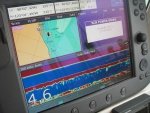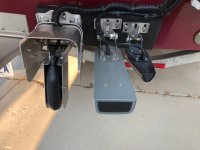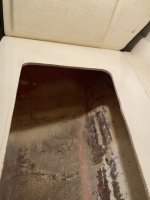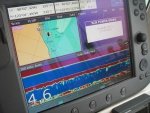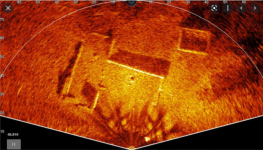Just wondering, IF this is way too crazy, or . . . ???

I am going ahead with a Raymarine upgrade which will include a new Transducer (RV-100), that will have RealVision 3D, CHIRP DownVision, SideVision, high frequency CHIRP, and 600W 50/200kHz traditional sonar.
What it doesn’t have are 2 important features that I am looking for, or use currently:
1. Real time, current (actual) water speed. (Have now via a paddle wheel on my P-66 Airmar transducer.)
2. Forward looking capability. Since I’m doing an upgrade, would love to have this capability without the HUGE transducer that hangs down under the hull. (Not something for a trailer boat.)
This brings me to two major questions:
1. To get water speed, I need to keep my old p66 transducer (Airmar). In doing that I lose the best place to mount a transducer, (between the down rotation side of my twin 40 Yami, and the inboard side of the trim tab,) not giving that spot to the new RV-100. Instead, the RV-100 RealVision 3D All-In-One Transom Mount CHIRP Transducer looks to be getting the second-best position, between the Twin 40’s, and just to Port of the cockpit drain hole. This will be about 10 inches from the Port side OB, and about 13 inches from the center of the Stbd OB and 16-18 from the up-rotation side of the prop.
Q #1. Does this sound like a reasonable plan to go forward with?
2. The Side scan 3D features reads to 300 feet each side, and down to 300 feet. So here is really where I may be so far out of the box I might be off on the next pallet (planet), but . . . . . . here goes - What if I fabricate a transducer mount that would allow me to rotate the RV-100 90 degrees(*) counterclockwise. That would let the starboard view then become a forward view, and allow me to look for bumpy hard things in my direction of travel when looking for some nook and cranny anchoring hole. (Please refer to the opening photo as an example.) This would be a manual operation, and only for 3 knots and under, mildly calm conditions, and would be for short term use only. AND manually changed back to normal position after anchoring, and that would show the anchorage, side to side.
Q #2. Does this sound anywhere near NOT CRAZY? Does it sound like a reasonable function for the fancy sounder version?
Well maybe more than two. :embarrased
Q #3. Is there anyone currently running more than one sounder transducer? If so, how far apart are they? Have you had any interference between them?
Q #4. Anyone here running twins, with a transducer mounted between the OB’s? Any adverse issues with that set up?
Anyone with any experience any way related to any of these issues, Please, speak up. I’m getting close to decision time here and this is a pretty major investment so I would really like to do it right and be able to move forward with a degree of confidence. I know the insight level of the C-BRAT community is WAY above normal so my trust level here is considerable.
Thanks for reading this far, and thanks in advance for any comments, negative or positive.
Harvey
SleepyC:moon
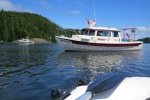
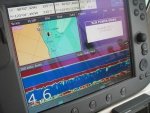

I am going ahead with a Raymarine upgrade which will include a new Transducer (RV-100), that will have RealVision 3D, CHIRP DownVision, SideVision, high frequency CHIRP, and 600W 50/200kHz traditional sonar.
What it doesn’t have are 2 important features that I am looking for, or use currently:
1. Real time, current (actual) water speed. (Have now via a paddle wheel on my P-66 Airmar transducer.)
2. Forward looking capability. Since I’m doing an upgrade, would love to have this capability without the HUGE transducer that hangs down under the hull. (Not something for a trailer boat.)
This brings me to two major questions:
1. To get water speed, I need to keep my old p66 transducer (Airmar). In doing that I lose the best place to mount a transducer, (between the down rotation side of my twin 40 Yami, and the inboard side of the trim tab,) not giving that spot to the new RV-100. Instead, the RV-100 RealVision 3D All-In-One Transom Mount CHIRP Transducer looks to be getting the second-best position, between the Twin 40’s, and just to Port of the cockpit drain hole. This will be about 10 inches from the Port side OB, and about 13 inches from the center of the Stbd OB and 16-18 from the up-rotation side of the prop.
Q #1. Does this sound like a reasonable plan to go forward with?
2. The Side scan 3D features reads to 300 feet each side, and down to 300 feet. So here is really where I may be so far out of the box I might be off on the next pallet (planet), but . . . . . . here goes - What if I fabricate a transducer mount that would allow me to rotate the RV-100 90 degrees(*) counterclockwise. That would let the starboard view then become a forward view, and allow me to look for bumpy hard things in my direction of travel when looking for some nook and cranny anchoring hole. (Please refer to the opening photo as an example.) This would be a manual operation, and only for 3 knots and under, mildly calm conditions, and would be for short term use only. AND manually changed back to normal position after anchoring, and that would show the anchorage, side to side.
Q #2. Does this sound anywhere near NOT CRAZY? Does it sound like a reasonable function for the fancy sounder version?
Well maybe more than two. :embarrased
Q #3. Is there anyone currently running more than one sounder transducer? If so, how far apart are they? Have you had any interference between them?
Q #4. Anyone here running twins, with a transducer mounted between the OB’s? Any adverse issues with that set up?
Anyone with any experience any way related to any of these issues, Please, speak up. I’m getting close to decision time here and this is a pretty major investment so I would really like to do it right and be able to move forward with a degree of confidence. I know the insight level of the C-BRAT community is WAY above normal so my trust level here is considerable.
Thanks for reading this far, and thanks in advance for any comments, negative or positive.
Harvey
SleepyC:moon




